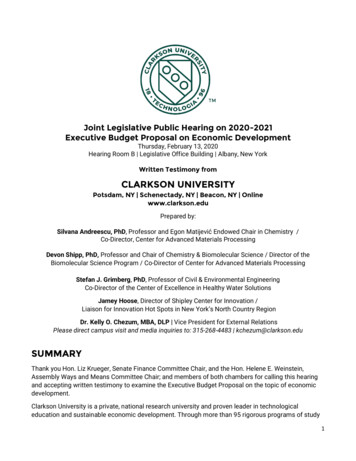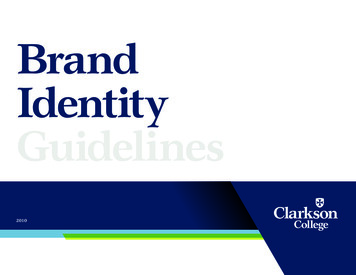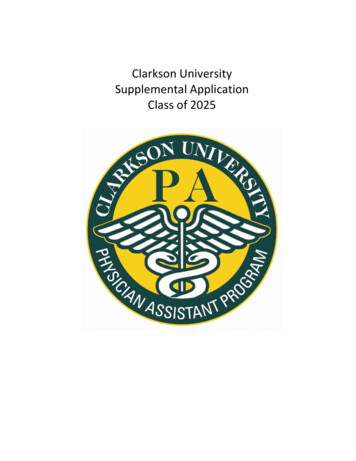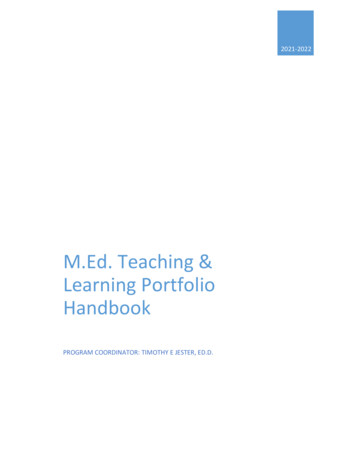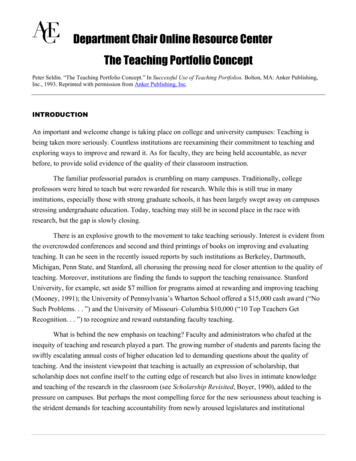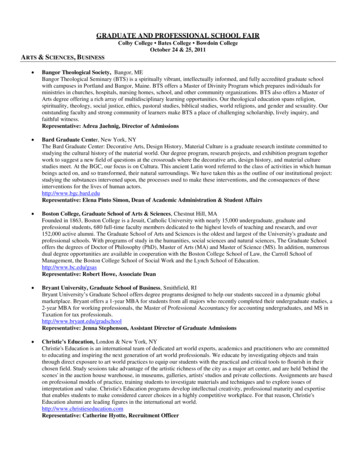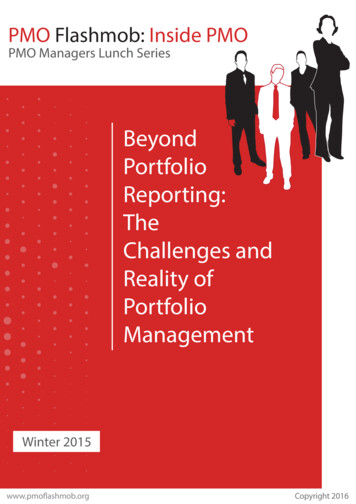
Transcription
Teaching PortfolioCraig W. Clarkson, PhDProfessor of Pharmacology
Section 1: BiographyDr. Clarkson was born in Waupaca, a small town in central Wisconsin. Being the son of an armydentist, he ended up living in several states during his formative years (Alaska, Texas, Michigan& Washington) as well as in two locations in Germany (Pirmasens & Munich). Dr. Clarksonobtained his undergraduate training at the University of Puget Sound in Tacoma WA where hegraduated with a BS in Biology & Chemistry in 1977. One of the elective courses Dr. Clarksontook during his 2nd year in college was a one month course on marine biology in Hawaii wherehe worked with a team to refine HPLC techniques to purify a marine toxin (Ciguatera)responsible for causing major health problems in the South Pacific & Carribean. This projectsparked an interest in pharmacology, and was the catalyst for causing him to enter graduateschool in pharmacology at Northwestern University under the mentorship of Robert E TenEick,PhD. After receiving his PhD in 1982 he completed 3 years of postdoctoral training under LucHondeghem, MD, PhD at the University of California, San Francisco.In 1985, Dr. Clarkson joined the faculty at Tulane as an assistant professor in pharmacology.Over the years he took on an increased responsibility for teaching including the role of coursedirector for Medical Pharmacology in 1997. Following hurricane Katrina, he also took over theresponsibility of director of graduate studies for the pharmacology department's doctoral andmasters programs.Dr. Clarkson believes that adults learn most effectively when they are actively engaged in theirown learning. As a result, he has helped to implement several interactive, learner-centeredapproaches into the medical curriculum including problem based learning, team based learning,just-in-time-teaching and peer instruction. He is the recipient of 11 teaching awards from themedical student's honor society (Owl Club), as well as the Sr Vice President's Teaching Scholaraward, the Tulane President's Award for Excellence in Teaching & the Alpha Omega AlphaRobert Glaser Teaching Award. At Tulane, he serves as the Chair of the Educational TechnologyCommittee & the Student Affairs Committee. He is also a member of the CurriculumCommittee, T2 Curriculum Subcommittee, Evaluation & Assessment Committee, and theBiomedical Sciences Steering Committee. On a national level, Dr. Clarkson is a member of theAmerican Society for Pharmacology & Experimental Therapeutics (ASPET), the NationalDirectors of Graduate Studies in Pharmacology & the International Association of MedicalSchool Educators (IAMSE). He has also served as the Medical Schools Representative to theUnited States Pharmacopeial Convention (2005-2010).
Section 2: Teaching VitaeDepartment of Pharmacology, Tulane University School of Medicine 8683, 1430 Tulane Avenue, NewOrleans, LA 70112-2699 Tele: (504) 988-2641 Fax: (504) 988-6761, Email: cclarks@tulane.eduURL: rkson.cfmPersonal Background: Born on September 22, 1955, Waupaca Wisconsin.Professional and Academic History: B.S. in Biology and Chemistry1977Univ. of Puget Sound, Tacoma WA Ph.D. in Pharmacology1982Northwestern Univ., Chicago, IL Postdoctoral Research Pharmacologist1982-1985Dept. of Pharmacology, Univ Calif San Francisco Assistant Professor1985-1990Dept. of Pharmacology, Tulane Univ.,School of Medicine, New Orleans LA Associate Professor1990-1995Dept. of Pharmacology, Tulane Univ.,School of Medicine, New Orleans LA Professor1995-presentDept. of Pharmacology Tulane Univ.,School of Medicine, New Orleans LA Director of Graduate Studies in Pharmacology2005-presentDept. of Pharmacology, MS & PhD programsTulane Univ., School of Medicine, New Orleans LAEducation-Related Honors & Awards: Owl Club Teaching Honor Roll*1997 Owl Club Teaching Award - Outstanding 2nd Year Teaching Award1998 Owl Club Second Year – Outstanding Professor, 2nd Semester2001 Owl Club Second Year – Student Advocate2002 Owl Club Second Year – Professor of the Year, Honorable Mention2004 Owl Club Second Year – Professor of the Year Teaching Award2006 Owl Club Second Year – Category 5 Teaching Award**2006
Owl Club Second Year – Professor of the Year Teaching Award2007 Owl Club Second Year – Professor of the Year Teaching Award2008 Senior Vice President’s Teaching Scholar Award (Tulane SOM)2008 President’s Award for Excellence in Teaching (Tulane Univ)2008 Owl Club Second Year – Professor of the Year, Honorable Mention2009 Owl Club Second Year – Clifford Newman Student Advocacy Award(for Members of the TmedWeb Team). 2009Alpha Omega Alpha Medical Honor Society Teaching AwardTulane University School of Medicine2009 Owl Club Second Year – Professor of the Year Teaching Award2011 Gloria P Walsh Award for Teaching Excellence (Owl Club)2011 Owl Club Second Year - Honorable Mention Best T2 Professor2012I'm not sure, but I think this is like coming in 5th place in the Olympics Owl Club T2 "Humerus" Award2013 Owl Club T2 "Humerus" Award2014 Owl Club T2 Best PBL or TBL Facilitator Teaching award2015 Owl Club T2 Professor of the year Teaching award2016 Fellow of the Academy of Pharmacology Educators (ASPET)2017 Owl Club Leon A Weisberg Excellence in Clinical Teaching Award2017 Owl Club T2 Teaching Excellence Award2017 Owl Club T1 Module of the Year (Cardiovascular) Award2017 Owl Club T2 Best PBL or TBL Facilitator Award2017* Tulane Univ School of Medicine (Student Honor Society)** “For the five exceptional individuals keeping medical education afloat come hell and high water.”Awarded the year after Hurricane Katrina.Educational Grant Funding: Tulane Office of Educational Research & Services. Teaching & Learning Innovations in Medical Education IncentiveMini-Grant (TIME).Craig W. Clarkson, P.I. “Digital Video Recording of Cardiovascular DrugResponses For Replacement of Live Animal Labs” 1999-2000. 3,000.Educational Professional Memberships: International Association of Medical Science Educators (IAMSE)Tulane University Society of Teaching Scholars, School of MedicineAcademy of Pharmacology Educators (ASPET)2003-present2008-present2017-present
Visiting Professorships / External Department Reviews: American University of Antigua College of Medicine, Dept. of Pharmacology,Antigua, Caribbean. April 2005 & February 2006. Nine hours of lectures to medical students.St. George's University, School of Medicine. External Review/Site Visit of theDept. of Pharmacology & Medical Pharmacology course, St. George's, Grenada, April 5-8, 2009Course Director Positions: Medical Pharmacology (2nd year medical course)1997-present Systems Biology (BMS Doctoral Program)2007-2012 (1 yr pilot project involving active learning in grad education) Advanced Topics in Cardiovascular Pharmacology (Graduate)Concepts in Pharmacology (Masters program) 2010-presentPharmacology ePortfolio (Graduate)2011-presentMol & Cell Pharm (formerly Pharm Research )(Graduate)HEAL-X Cardiovascular block Co-director (w/ Dr. Elma LeDoux)Cardiac PhysiologyWhole Animal ElectrocardiographyCardiac ArrhythmiasMembrane transporters & mitochondrial functionDrug Receptor Theory / Basic Principles of PharmacologyMedical Teaching:Medical Physiology (1st year) - Lectures Principles of Cardiac Excitation & Contraction (2hrs)Introduction to the electrocardiogram (1 hr)Medical Physiology (1st year) - JiTT Sessions Cardiac Arrhythmias, Cellular Basis & ECG Interpretation (2 hrs)Medical Pharmacology (2nd year) – Lectures 2008Principles of Pharmacology (Graduate)Graduate Teaching: 2000-2013PharmacokineticsHepatic Drug ClearanceAntianginal Drugs2010-present2013 & 2014
Drugs used in Rx of AsthmaGeneral & Local AnestheticsSedative / Hypnotic / AnxiolyticsAntipsychoticsPsychostimulants, Drugs of AbuseDrug Responses in Children, Women & the ElderlyHerbal DrugsMedical Pharmacology (2nd year) – JiTT Sessions Basic Principles of Medical Pharmacology JiTTCholinergic Pharmacology JiTTAntiarrhythmic Drugs JiTTTreatment of Heart Failure & Digoxin Pharm JiTTAntidepressants, MAO inhibitors & Li JiTTMedical Pharmacology (2nd year) – Block Reviews Basic Principles & Rx of InflammationANS & CV PharmacologyRenal BlockCNS Drugs / Neurology BlockPsychiatry blockEndocrine & Reproductive BlockMedical Pharmacology (2nd year) - Team Based Learning Autonomic UnknownsRx of DiabetesRx of Heart Failure (a collaboration with Dr. Elma LeDoux)Coagulation Disorders (a collaboration with Dr. Marc Kahn)Medical Pharmacology (2nd year) - Problem Based Teaching Drug Metabolism & Drug InteractionsChemical Warfare in IraqHypertensionAntiarrhythmic Drugs & Rx of acute MI - Clinical Problem SolvingOral Contraceptives – Clinical Problem SolvingTreatment of Depression – Clinical Problem SolvingHuman Patient Simulation (2nd year) - METIman (Adult & Pediatric) Diagnosis & Treatment of Unstable Angina & Cardiac Arrhythmias(a collaborative project with Dr. Elma LeDoux MD)
Diagnosis & Treatment of Acute Bronchoconstriction (pediatric) - currently not being used(a collaborative project with Dr. Scott Davis, MD)Diagnosis & Treatment of Severe Pain - gunshot wound(a collaborative project with Dr. Elma LeDoux MD)Case-based Learning Modules with Self Assessment (2nd year) - Pharmwiki (include: clinical case, pathophysiology, clinical diagnosis, treatment, interactive quizzes)AntimalarialsRx of HypertensionRx of BPHRx of AsthmaRx of AnginaRx of IBS & IBDIntroduction to CNS neurotransmitters & Rx of AlzheimersRx of MigraineAlcoholismContraceptivesRx of Diabetes (insulins, oral & parenteral hypoglycemics)Rx of DepressionRx of SchizophreniaEducation Related Committees:University or Medical Center Academic Computing1988-1993Admissions Committee1994-1999, 2005-presentSurgery Required Clerkship Review Committee1991-1993Senate Committee on Honors1997-1999University Senate Committee on Computing1998-2001Graduate CouncilCurriculum Committee2nd Year Clinical Curriculum Advisory CommitteeStudent Affairs Committee (chair since 2009)Educational Technology Committee (chair)Evaluation & Assessment Committee – SOMSimulation Center Research CommitteeMEDICAL EDUCATION:Course Director for Medical Pharmacology (1997 to ent2007- present2008-present2010-present (inactive)
For the past 20 years I have been the course director for this team-taught course that currentlyconsists of 54 hours of lectures (many with clicker questions), 7 hours of small group cased-basedProblem-Based-Learning (PBL) sessions, 8 hours of Team-Based-Learning sessions (4 TBLs), 10 casedbased online learning wiki modules with interactive self assessment exercises, 9 Just-in-Time-Teaching(JiTT) sessions, 2 Simulation sessions, 10 hrs of block review sessions & 11 hours of exams (111 hourstotal). I am personally responsible for teaching 20 hrs ( 25%) of lectures & JiTT sessions, 2 of the 4 TBLs,2 HPS Simulation exercises (12 sessions each) & participate in all PBL exercises. In addition, I amresponsible for scheduling, curricular development, continuing development of our wiki website(Pharmwiki), exam development, exam grading & evaluation, and working with other course directorsinvolved in our 2nd year medical curriculum who have courses that “dove-tail” with our content in ourintegrated medical curriculum. Teaching this course involves a total of over a dozen different facultyfrom pharmacology, psychiatry & medicine.Med Pharm was awarded the Owl Club “Course of the Year” Award in April/May 1998, 2000, 2008 & 2009, 2011 &.2016The Katrina Experiment in Medical EducationIn the Fall of 2005, following hurricane Katrina, most of the New Orleans area was under several feet ofwater for several weeks. At this time, the senior leadership in the School of Medicine (Drs. Kahn, Krane& Dean Taylor) developed a partnership with Dr. DeBakey & the Baylor College of Medicine, who offeredthe use of their medical campus to allow us to "restart" our school of medicine for the next 9 months inHouston. A handful of close colleagues from different departments (Drs. Beckman, Crawford, Daroca,Johnson, Kahn, Krane, Markert, Smith & Rajan) and myself relocated to Houston in mid September toput together a 2nd year medical curriculum utilizing a mixture of faculty from Baylor, MD Anderson &Tulane. We identified and contacted available teaching faculty, developed lecture handouts, andorganized the 2nd year curriculum in 2-3 week blocks, working on the next block while the current blockwas being delivered. BCM faculty & students utilized their classrooms for lectures & small groupsessions in the morning, and we utilized them in the afternoon. We all learned to give lectures on topicsoutside of our normal comfort zone, but we nevertheless managed to provide "almost" the same qualityof curriculum (based upon performance on both internal & standardized NBME shelf exams) that weprovided for our students in New Orleans. It was an interesting educational experiment, but not onethat any of us would care to repeat anytime soon.Facilitating Student Learning Thru Lecture RecordingThe average student can only transcribe 10% of the words spoken during a typical lecture. It is widelybelieved that having a resource for reviewing lecture content “after the fact” can aid student learning.During the summer of 2006, after returning from Houston, I worked with Niels Olson (a Naval engineer,and previous 4th year medical student) to develop a system for recording lectures to be given during theupcoming 2nd year medical curriculum. We settled upon using an Olympus digital audio recorderconnected to an audio feed from the podium. Niels did the lion’s share of recording, and I created &managed a website for uploading & storing the recordings. By the end of the year this evolved into thedevelopment of a “one stop shopping” web site where lecture slides and audio files for all T2 lecturescould be easily found & downloaded with little navigation involved. The following year, I began a
collaboration with Bobby Garner-Coffie in the SPH/TM that allowed us to perform a pilot study using theTegrity Classroom system for lecture capture of Med Pharm lectures. The following 2007-08 year the useof Tegrity was expanded to include recording of all T2 courses, and to a limited extent, for recording 1styear lectures. The use of the system was then expanded further to include the entire 1st & 2nd yearmedical curriculum, with funding provided by the SOM Deans office. In 2014 a University widesubcommittee was formed to evaluate different recording options, and shortly thereafter we switchedto using Mediasite as our classroom recording platform.Related Educational Presentation & Publication: Franklin DS, Gibson JW, Samuel JC, Teeter WA, Clarkson CW: Use and benefits of lecture recordings in medicaleducation. Southern Group on Educational Affairs. 2009 Annual Meeting, New Orleans, LA. Poster/Abstract #233.Franklin DS, Gibson JW, Samuel JC, Teeter WA, Clarkson CW: Use of lecture recordings in medical education. Med SciEducator 21(1): 21-28, 2011.Introduction of Active Learning StrategiesJust-in-Time-Teaching (JiTT) & Peer InstructionTraditional classroom lectures are “teacher-centered” and promote passive learning. There is a growingbody of evidence that indicates that active learning strategies can produce superior learning outcomescompared to traditional lectures. As a first step in implementing learner-centered / active learningstrategies, in 2008-2009 we converted seven traditional Med Pharm lectures to Just-in-Time-Teachingsessions. JiTT sessions require that students complete a reading assignment & a post-reading (graded)quiz on a LMS (e.g. Blackboard or Canvas) that has a deadline the night before the class session (e.g. theLMS will close access to the quiz at midnight or 3 AM). The quiz typically contains 2 or 3 MCQs, plus ashort answer essay question. The essay question asks students to reflect on the assignments learningobjectives and to briefly explain “What did you find most difficult or confusing about the reading?” (amethod designed to cause metacognition). These essay responses are scanned the morning before class& determine the areas to be focused on during class. Selection of previously created interactiveAudience Response System (clicker) questions before class that are related to the identified areas ofdifficulty transforms a traditional lecture into a class session focused mainly on areas of difficulty (vs. areview of material the class already understands from their reading). Students come to class preparedwith a background knowledge of the material.When clicker questions are utilized to stimulate discussion between students, the student interaction(referred to as "peer instruction") can produce a significant increase in short term understanding (asillustrated in the poster presentation shown below)(or see a larger version).
Related Educational Presentations & Workshops: Peer instruction enhances student performance on pharmacology quizzes. Clarkson CW, Agrawal KC, Mondal D.Southern Group on Educational Affairs. 2009 Annual Meeting, New Orleans, LA. Abstract/Poster #249.Active Learning & Learner-Centered Instruction. Changing the Emphasis from Teaching to Learning.Meeting of the National Directors of Graduate Studies in Pharmacology (New Orleans, LA, April 23rd, 2009) (New Orleans, LA, April 23rd, 2009) (New Orleans, LA, April 22nd, 2009) Meeting of the Group for Research in Pathology Education (GRIPE), Jan 15, 2010. New Orleans, LA.Small group workshop on Active Learning - National Directors of Graduate Studies in PharmacologyActive Learning - Robert Glaser Teaching Award (Post-dinner talk). Alpha Omega Alpha Medical Honor SocietyJust-in-Time-Teaching & Classroom Response Systems. Changing the Emphasis from Teaching to Learning. AnnualIAMSE Workshop on Just-in-Time-Teaching in Medical Education.Clarkson CW, Franklin, D International Asson. ofMedical School Educators (IAMSE) Meeting, Portland OR, June 25th, 2012.Team Based Learning (TBL)The same year that I introduced JiTT into our medical curriculum, I also worked with Drs Kahn, Krane,Crawford and several other faculty to develop and introduce several sessions utilizing the Team Based
Learning method (for further information, see http://www.teambasedlearning.org/). The TBL design hassimilarities to JiTT, but utilizes class time primarily for assessment and group exercises. During the firstsemester that we initiated TBL into the curriculum, I designed an exercise on Autonomic Pharmacologythat includes a group exercise on identifying four different "ANS drug unknowns" based upon how theymodify blood pressure responses to various agonists (ACh, NorEpi, Epi, isoproterenol, tyramine) and CVmaneuvers (vagal stimulation, double carotid occlusion). I also worked with clinical colleagues over thefollowing year to develop TBL exercises on treatment of diabetes, coagulation disorders, and heartfailure. In general, replacement of didactic lectures with TBL exercises increased exam performance(internal exams & NBME standardized exams) significantly (but only by a few percent). The most markedimprovement was seen in students whose grades are below the class mean (who seem to benefit themost from active learning exercises, in general).Related Educational Presentations & Workshops: Daniel A, Crawford B, Krane K, Kahn M, Clarkson C, Dise T, Klingsberg R. Workshop: A Team Approach toImplementing Team-based Learning: Lessons Learned. April 3, 2009. Abstract #228 Southern Group on Education Affairs (SGEA), New Orleans 6/30/2009.Kahn M, Clarkson C, Crawford B: Coagulation Team Based Learning Exercise. MedEdPORTAL. AAMC #4054Ficarra M, Crawford B, Clarkson C, Barrett D, Gibson J: Assessment of Learning in TBL Educational Sessions. IAMSEAnnual Meeting, Poster presentation, July 10, 2010.Human Patient Simulation:Three METI Human Patient Simulations were developed and implemented for our 2nd year medical classin 2009-2010, shortly after the opening of the Tulane Simulation Center.The first simulation designed was focused on the diagnosis & treatment of unstable angina & cardiacarrhythmias using the adult METI Human Patient Simulator. The outline for the simulation (case history& story line) was developed by Drs Krane, LeDoux and I. Using the case outline, I developed a METI HPSscenario to emulate the patient's presenting heart rate & blood pressure, and a METI scenario forsimulating the onset of unstable angina with ST segment depression & associated changes in heart rate& blood pressure. The simulation included responses to drug administration (nitroglycerin, morphine,oxygen, metoprolol), simulation of various arrhythmias (bradycardia, AV block, VTach, VFib) andtreatments (Cardioversion/Defibrillation, amiodarone, lidocaine & atropine). Dr. LeDoux played the roleof the ER physician, and I coordinated the simulation via a laptop computer from a control room behinda one-way mirror & played the voice of the patient "Mr. Boudreaux".A second simulation was on the diagnosis & treatment of severe bronchoconstriction in a pediatricpatient (using the 6 yo METI Human Patient Simulator). The objectives of this simulation were focusedon students being able to work as a team to get the patient's history from a parent (played by asimulation staff member with a Theatre background), assess the patients status (BP, HR,RR, O2 Sat, LungSounds), make a diagnosis & apply treatment in the right order (O2, beta-2 agonist, steroid), followed byreassessment & ultimately "handing off" the patient to an attending physician (Scott Davis, MD pediatrician). The simulation exercise was followed by a 30-45 min debriefing by Dr. Scott Davis. Icoordinated the simulation via a laptop computer & played the voice of the patient "Wheezing Willy".
A third simulation on the treatment of severe pain was developed for the Neurology block. Thissimulation developed involved "Mr Tibideaux" (an alcoholic with a history of stomach ulcers) who wasthe victim of a gun shot wound to the leg while in a local bar. He also suffered a laceration of the areaaround his eye from a piece of flying glass. In the Emergency department he is evaluated by the ERphysician and students. As the scenario evolves he is given morphine (vs ketorolac), suffers a morpineoverdose, requires naloxone. When his eye is examined, eye pressure produces a severe bradycardia,requiring treatment with atropine. A discussion of treatment options, side effects, and drug interactionsis easily covered as the scenario develops. Developed with Dr. Elma LeDoux.To assess the educational impact of active participation in Simulation exercises, in 2011 we comparedthe scores obtained on two block exams for questions that were related to concepts addressed to theSim sessions (but were also covered in lecture or self studies), vs exam scores on questions unrelated tothe Sim exercises. Scores were compared for students who were present for the Sim exercise, vs thosewho were absent. As shown below, those who were inside the ER room during the Sim exercisessignificantly outperformed those who were absent, even though the same material being tested on wascovered in previous lectures. A similar difference was not seen between the two groups for other examquestions. As a result, we made attendance of Sim sessions "mandatory" in the years that followed(mandatory meaning that students are given points for attendance & participation).
Related Educational Presentations & Workshops: Using Human Patient Simulators to Enhance Basic Science Education Throughout the Undergraduate MedicalCurriculum. IAMSE Faculty Development Course, July 10, 2010. Susan Pasquale, John L Szarek, Elma LeDoux, Craig W Clarkson. Tulane University.It's About the Science: The Art and Science of Using Human Patient Simulators to Enhance Basic Science Education. SChauvin, C W Clarkson, J Szarek, R Ten Eyck. Podium Presentation #608. Society for Simulation in Healthcare (AnnualMeeting, New Orleans) 1/25/11.Medical Wikis & Interactive Self-Assessment Quizzes (Pharmwiki):Over the past 7 years I have been developing an interactive Pharmwiki for our Medical curriculum that isdesigned to provide a "one stop shopping" information & learning resource for our medical & graduatestudents. It contains: Essential drug information with cited references (e.g. Original articles, Katzung's Pharmacology text, Harrison'sInternal Medicine)Case-based learning modules on 19 different topics that summarize:disease pathophysiologypatient signs & symptomsclinical diagnosistreatment optionsInteractive formative assessment quizzes (on 46 topics, 750 questions)The Pharmwiki resource is intended to explain different systems-based topics in pharmacology topics,whenever possible in their appropriate "clinical context" in order to provide "mental scaffolding" topromote long-term retention & understanding of pharmacology. The primary philosophy in the designof Pharmwiki has been to be "correct, concise & clear". Pharmwiki has heavily emphasized the use ofinteractive self-assessment quizzes because educational research (conducted at different levels, frommiddle school to post-graduate medical education) has shown that taking frequent quizzes provides aform of "mental retrieval practice" that can produce a better recall of facts and a deeper understandingcompared to an education devoid of self assessment (Dobson, 2008; Karpicke & Roediger, 2008; Loganet al, 2011; McDermott et al, 2014; Reed et al, 2014; Paul, 2015). As shown below, a 2011 survey of 2ndyear medical students indicated that Pharmwiki was the #1 primary information resource for studentstaking Medical Pharmacology.Pharmwiki url: http://tmedweb.tulane.edu/pharmwiki/doku.php/
Related Educational Presentations & Workshops: Wikis and Interactive Quizzes - Technology Our Students Really Use to Learn. Clarkson CW.Tulane School of MedicineEducational Technology Retreat, May 1, 2012.GRADUATE EDUCATION:Director of Graduate Studies in Pharmacology &Resurrection of Our Graduate Curriculum After Katrina:In December 2005, while I was living in Houston following Katrina, my chairman placed me in charge ofour department’s doctoral and masters graduate programs. At the time of the storm we had 40 mastersstudents and 12 doctoral students in the pharmacology graduate program. When classes resumed atthe New Orleans downtown campus in mid-January of 2006, we had 25 masters students return, alongwith 6 doctoral students. During several trips back from my duties at Baylor, I found rooms (withacceptable air quality) that we could use for teaching in portions of the 1430 Tulane Ave building,although we tried to use the Gene Therapy conference room in the JBJ building whenever it wasavailable. With limited access to classrooms & a reduced number of available faculty, I heavily revisedour graduate curriculum, so that we could complete all previously scheduled graduate classes for the2005-06 academic year during the Spring semester of 2006 & an extra Summer lagniappe semester in
June-July of 2006. One component of this challenge was to find a way to simultaneously teach ourcomplete Medical Pharmacology course at both the New Orleans campus (to our doctoral & mastersstudents) & Baylor campus (to our medical students). Lectures on the two campuses had to bescheduled out of sync with each other, since our remaining teaching faculty could not be in two placesat once. This was not a fun year.Development of a Thematic & Objective-Based Graduate Curriculum (2006-07):During the summer of 2006, in response to student criticisms about our graduate curriculum, I made aseries of major changes to our department’s graduate curriculum. These changes were based upon a“proven” design – that of our 2nd year medical curriculum which I had been involved with designingover the previous decade: I rearranged our traditional graduate curriculum to replace it with a thematic “organ-system” based design in which(as much as possible) all lectures in all graduate courses covered the same theme being covered in MedicalPharmacology. This included topics covered in our seminars & weekly journal club. This change was designed to re- inforce student learning.With the help of our faculty, a list of specific learning objectives was developed for each graduate lecture given in ourtwo primary graduate courses: Principles of Pharmacology & Pharmacology Research. Exams were designed to cover the material outlined in the learning objectives. Graduate exams were placed at the end of each Med Pharm “thematic block”. time to students. This allowed students to prepare for lectures ahead of time.Lecture handouts, containing learning objectives, were collated prior to each thematic block & distributed ahead-ofAudio recordings of graduate lectures were initiated in the Fall of 2006 and a Graduate Resources website wasdeveloped that included the new thematic lecture schedule, and a media website was designed to provide links todown-loadable versions of all lecture audio recordings & lecture slides (html & pdf versions). One of my new dutiesbecame the development, maintainance & archieving of this website. During the 2008-09 academic year, we switchedto use of the Tegrity Classroom recording system for graduate lectures, and then in 2014 we switched to usingMediasite.Graduate Resources Website url: dresources/index.cfmRelated Educational Presentation: The Doctoral Program in Pharmacology at Tulane University – Post Katrina. Meeting of the National Directors ofGraduate Studies in Pharmacology (Salt Lake City, Utah, July 25-28th, 2007 )Systems Biology Course Directorship (2008-2012):The Systems Biology Course was a newly constructed course, first offered in Spring 2007 for the 1st yeardoctoral students in our newly created umbrella “Biomedical Sc
Section 2: Teaching Vitae Department of Pharmacology, Tulane University School of Medicine 8683, 1430 Tulane Avenue, New Orleans, LA 70112-2699 Tele: (504) 988- 2641 Fax: (504) 988-6761, Email: cclarks@tulane.edu
